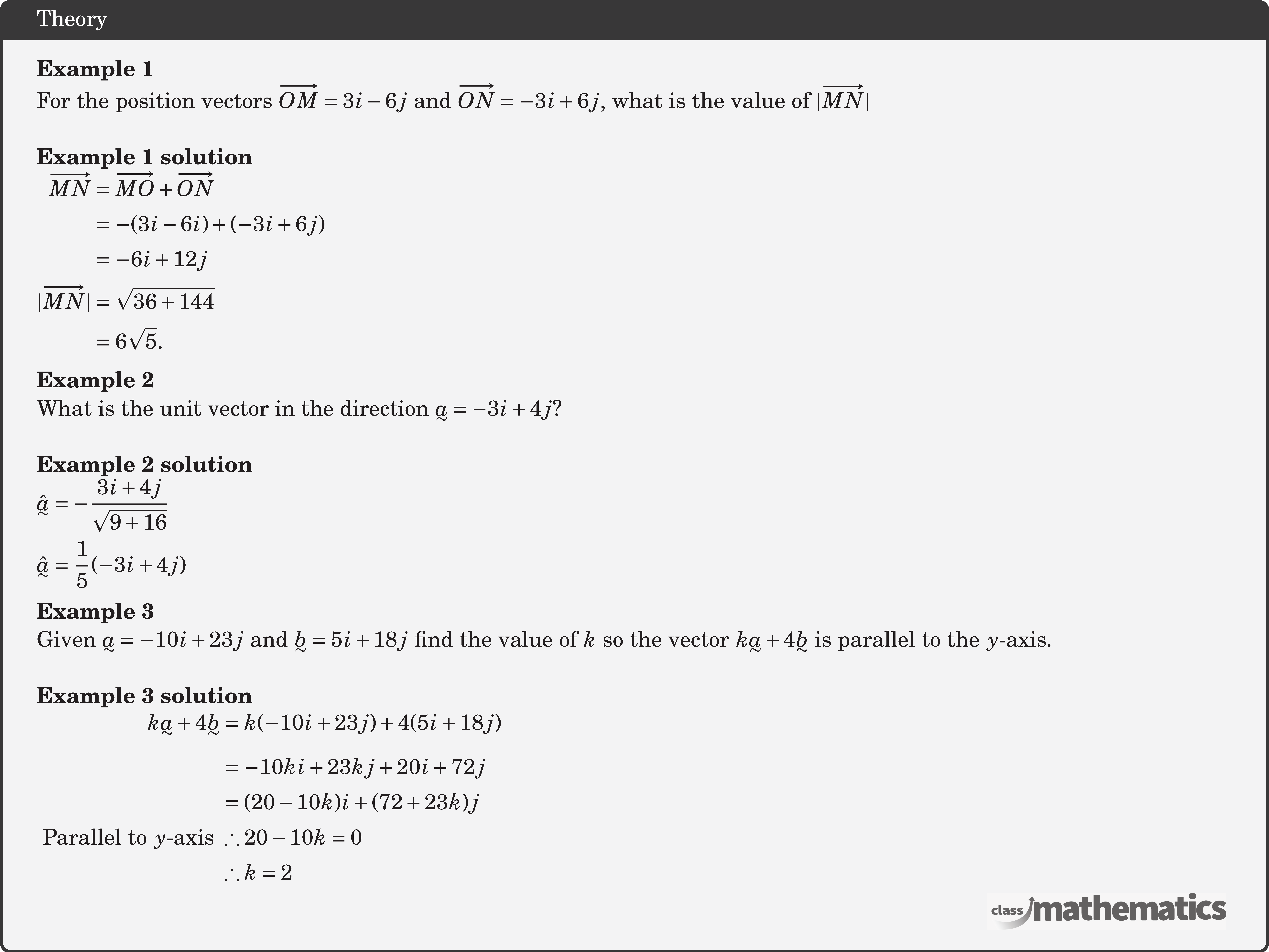Resources for Vectors in Component Form
-
Video Tutorials
1
Click Here
Vectors in Component Form Theory
![The unit vector in the direction $\underset{\raise0.3em\hbox{$\smash{\scriptscriptstyle\thicksim}$}}{a} $ is denoted $\underset{\raise0.3em\hbox{$\smash{\scriptscriptstyle\thicksim}$}}{\hat{a}}$ where $\underset{\raise0.3em\hbox{$\smash{\scriptscriptstyle\thicksim}$}}{\hat{a}}$ \(=\dfrac{\underset{\raise0.3em\hbox{$\smash{\scriptscriptstyle\thicksim}$}}{a} }{|\underset{\raise0.3em\hbox{$\smash{\scriptscriptstyle\thicksim}$}}{a} |}\).\\ The component form of the vector $\underset{\raise0.3em\hbox{$\smash{\scriptscriptstyle\thicksim}$}}{a} $ is $\underset{\raise0.3em\hbox{$\smash{\scriptscriptstyle\thicksim}$}}{a} $\(=x i+y j\) which is equivalent to the column vector \(a=\left(\begin{array}{l}x \\ y\end{array}\right)\)\\ The magnitude of the vector $\underset{\raise0.3em\hbox{$\smash{\scriptscriptstyle\thicksim}$}}{a} $\(=x i+y i\) is \(|\underset{\raise0.3em\hbox{$\smash{\scriptscriptstyle\thicksim}$}}{a}|=\sqrt{x^2+y^2}\) Addition of vectors in component form if \(\underset{\raise0.3em\hbox{$\smash{\scriptscriptstyle\thicksim}$}}{a}=x_1 i+y_1 j\) and \(\underset{\raise0.3em\hbox{$\smash{\scriptscriptstyle\thicksim}$}}{b}=x_2 i+y_2 j\) then \(\underset{\raise0.3em\hbox{$\smash{\scriptscriptstyle\thicksim}$}}{a}+\underset{\raise0.3em\hbox{$\smash{\scriptscriptstyle\thicksim}$}}{b}=\left(x_1+x_2\right) u+\left(y_1+y_2\right) j\)\\ Subtraction of vectors in component form if \(\underset{\raise0.3em\hbox{$\smash{\scriptscriptstyle\thicksim}$}}{a}=x_1 i+y_1 j\) and \(\underset{\raise0.3em\hbox{$\smash{\scriptscriptstyle\thicksim}$}}{b}=x_2 i+y_2 j\) then \(\underset{\raise0.3em\hbox{$\smash{\scriptscriptstyle\thicksim}$}}{a}-\underset{\raise0.3em\hbox{$\smash{\scriptscriptstyle\thicksim}$}}{b}=\left(x_1-x_2\right) i+\left(y_1-y_2\right) j\)\\ Scalar multiplication of vectors in component form if \(a=x i+y j\) then \(k a=k x i+k y j\) \begin{multicols}{2} \textbf{Relative position vectors} \begin{center} \resizebox{0.3\textwidth}{!}{ \begin{tikzpicture} \draw[step=1cm, line width=0.2mm, black!40!white] (-5,-5) grid (5,5); \draw [draw=black] (-5,-5) rectangle (5,5); \draw[latex-latex,line width=0.5mm] (-5.5,0) -- (5.5,0) node[right]{\Large\(x\)}; \draw[latex-latex,line width=0.5mm] (0,-5.5) -- (0,5.5)node[above]{\Large\(y\)}; \foreach \x in {-5,-4,-3,-2,-1,1,2,3,4,5} \draw[thin] (\x,3pt )--(\x, -3pt ) node[anchor=north]{\Large\(\x\)}; \foreach \y in {-5,-4,-3,-2,-1,1,2,3,4,5} \draw[thin] (3pt, \y )--(-3pt, \y) node[anchor=east]{\Large\(\y\)}; \coordinate [label=below left:\Large$\mathbf{O}$ ] (O) at (0,0); \coordinate [ label=above:\Large$\mathbf{A}$ ] (A) at (2,3); \coordinate [ label=below:\Large$\mathbf{B}$ ] (B) at (3,-2); \draw[line width=2pt] (O)--(A)--(B)--cycle; \path[decoration={markings, mark=at position 1 with {\arrow{latex[scale=4.5]}}}, postaction=decorate,line width=3pt] (O)--(A); \path[decoration={markings, mark=at position 1 with {\arrow{latex[scale=4.5]}}}, postaction=decorate,line width=3pt] (O)--(B); \path[decoration={markings, mark=at position 1 with {\arrow{latex[scale=4.5]}}}, postaction=decorate,line width=3pt] (B)--(A); \end{tikzpicture} } %\includegraphics[width=0.3\textwidth]{13ef2623-6326-470b-85f2-84fd73b74083} \end{center} \columnbreak The position vector of A relative to \(B\) is \(\overrightarrow{A B}\)\\ $\begin{aligned} & \overrightarrow{A B}=\overrightarrow{A O}+\overrightarrow{O B} \\ & \overrightarrow{O A}=2 i+3j, \overrightarrow{O B}=3 i-2 j \\ & \therefore \overrightarrow{A B}=-\overrightarrow{O A}+\overrightarrow{O B} \\ &=-2i-3j+3i-2j \\ &=i-5j \end{aligned}$\\ \end{multicols} \textbf{Parallel vectors}\\ If \(\underset{\raise0.3em\hbox{$\smash{\scriptscriptstyle\thicksim}$}}{b}=k \underset{\raise0.3em\hbox{$\smash{\scriptscriptstyle\thicksim}$}}{a}\) then $\underset{\raise0.3em\hbox{$\smash{\scriptscriptstyle\thicksim}$}}{b}$ is parallel to \(\underset{\raise0.3em\hbox{$\smash{\scriptscriptstyle\thicksim}$}}{a}\).\\ Unit vectors in component form $\begin{aligned} \hat{a} & =\dfrac{\underset{\raise0.3em\hbox{$\smash{\scriptscriptstyle\thicksim}$}}{a}}{|\underset{\raise0.3em\hbox{$\smash{\scriptscriptstyle\thicksim}$}}{a}|} \\ \text { If } \underset{\raise0.3em\hbox{$\smash{\scriptscriptstyle\thicksim}$}}{a} & =x i+y j \\ \text { then } \hat{a} & =\dfrac{x i+y j}{\sqrt{x^2+y^2}} \\ \text { OR } \hat{a} & =\dfrac{1}{\sqrt{x^2+y^2}}(x i+y j) \end{aligned}$\\](/media/5lmfurif/3951.png)

1
![The unit vector in the direction $\underset{\raise0.3em\hbox{$\smash{\scriptscriptstyle\thicksim}$}}{a} $ is denoted $\underset{\raise0.3em\hbox{$\smash{\scriptscriptstyle\thicksim}$}}{\hat{a}}$ where $\underset{\raise0.3em\hbox{$\smash{\scriptscriptstyle\thicksim}$}}{\hat{a}}$ \(=\dfrac{\underset{\raise0.3em\hbox{$\smash{\scriptscriptstyle\thicksim}$}}{a} }{|\underset{\raise0.3em\hbox{$\smash{\scriptscriptstyle\thicksim}$}}{a} |}\).\\ The component form of the vector $\underset{\raise0.3em\hbox{$\smash{\scriptscriptstyle\thicksim}$}}{a} $ is $\underset{\raise0.3em\hbox{$\smash{\scriptscriptstyle\thicksim}$}}{a} $\(=x i+y j\) which is equivalent to the column vector \(a=\left(\begin{array}{l}x \\ y\end{array}\right)\)\\ The magnitude of the vector $\underset{\raise0.3em\hbox{$\smash{\scriptscriptstyle\thicksim}$}}{a} $\(=x i+y i\) is \(|\underset{\raise0.3em\hbox{$\smash{\scriptscriptstyle\thicksim}$}}{a}|=\sqrt{x^2+y^2}\) Addition of vectors in component form if \(\underset{\raise0.3em\hbox{$\smash{\scriptscriptstyle\thicksim}$}}{a}=x_1 i+y_1 j\) and \(\underset{\raise0.3em\hbox{$\smash{\scriptscriptstyle\thicksim}$}}{b}=x_2 i+y_2 j\) then \(\underset{\raise0.3em\hbox{$\smash{\scriptscriptstyle\thicksim}$}}{a}+\underset{\raise0.3em\hbox{$\smash{\scriptscriptstyle\thicksim}$}}{b}=\left(x_1+x_2\right) u+\left(y_1+y_2\right) j\)\\ Subtraction of vectors in component form if \(\underset{\raise0.3em\hbox{$\smash{\scriptscriptstyle\thicksim}$}}{a}=x_1 i+y_1 j\) and \(\underset{\raise0.3em\hbox{$\smash{\scriptscriptstyle\thicksim}$}}{b}=x_2 i+y_2 j\) then \(\underset{\raise0.3em\hbox{$\smash{\scriptscriptstyle\thicksim}$}}{a}-\underset{\raise0.3em\hbox{$\smash{\scriptscriptstyle\thicksim}$}}{b}=\left(x_1-x_2\right) i+\left(y_1-y_2\right) j\)\\ Scalar multiplication of vectors in component form if \(a=x i+y j\) then \(k a=k x i+k y j\) \begin{multicols}{2} \textbf{Relative position vectors} \begin{center} \resizebox{0.3\textwidth}{!}{ \begin{tikzpicture} \draw[step=1cm, line width=0.2mm, black!40!white] (-5,-5) grid (5,5); \draw [draw=black] (-5,-5) rectangle (5,5); \draw[latex-latex,line width=0.5mm] (-5.5,0) -- (5.5,0) node[right]{\Large\(x\)}; \draw[latex-latex,line width=0.5mm] (0,-5.5) -- (0,5.5)node[above]{\Large\(y\)}; \foreach \x in {-5,-4,-3,-2,-1,1,2,3,4,5} \draw[thin] (\x,3pt )--(\x, -3pt ) node[anchor=north]{\Large\(\x\)}; \foreach \y in {-5,-4,-3,-2,-1,1,2,3,4,5} \draw[thin] (3pt, \y )--(-3pt, \y) node[anchor=east]{\Large\(\y\)}; \coordinate [label=below left:\Large$\mathbf{O}$ ] (O) at (0,0); \coordinate [ label=above:\Large$\mathbf{A}$ ] (A) at (2,3); \coordinate [ label=below:\Large$\mathbf{B}$ ] (B) at (3,-2); \draw[line width=2pt] (O)--(A)--(B)--cycle; \path[decoration={markings, mark=at position 1 with {\arrow{latex[scale=4.5]}}}, postaction=decorate,line width=3pt] (O)--(A); \path[decoration={markings, mark=at position 1 with {\arrow{latex[scale=4.5]}}}, postaction=decorate,line width=3pt] (O)--(B); \path[decoration={markings, mark=at position 1 with {\arrow{latex[scale=4.5]}}}, postaction=decorate,line width=3pt] (B)--(A); \end{tikzpicture} } %\includegraphics[width=0.3\textwidth]{13ef2623-6326-470b-85f2-84fd73b74083} \end{center} \columnbreak The position vector of A relative to \(B\) is \(\overrightarrow{A B}\)\\ $\begin{aligned} & \overrightarrow{A B}=\overrightarrow{A O}+\overrightarrow{O B} \\ & \overrightarrow{O A}=2 i+3j, \overrightarrow{O B}=3 i-2 j \\ & \therefore \overrightarrow{A B}=-\overrightarrow{O A}+\overrightarrow{O B} \\ &=-2i-3j+3i-2j \\ &=i-5j \end{aligned}$\\ \end{multicols} \textbf{Parallel vectors}\\ If \(\underset{\raise0.3em\hbox{$\smash{\scriptscriptstyle\thicksim}$}}{b}=k \underset{\raise0.3em\hbox{$\smash{\scriptscriptstyle\thicksim}$}}{a}\) then $\underset{\raise0.3em\hbox{$\smash{\scriptscriptstyle\thicksim}$}}{b}$ is parallel to \(\underset{\raise0.3em\hbox{$\smash{\scriptscriptstyle\thicksim}$}}{a}\).\\ Unit vectors in component form $\begin{aligned} \hat{a} & =\dfrac{\underset{\raise0.3em\hbox{$\smash{\scriptscriptstyle\thicksim}$}}{a}}{|\underset{\raise0.3em\hbox{$\smash{\scriptscriptstyle\thicksim}$}}{a}|} \\ \text { If } \underset{\raise0.3em\hbox{$\smash{\scriptscriptstyle\thicksim}$}}{a} & =x i+y j \\ \text { then } \hat{a} & =\dfrac{x i+y j}{\sqrt{x^2+y^2}} \\ \text { OR } \hat{a} & =\dfrac{1}{\sqrt{x^2+y^2}}(x i+y j) \end{aligned}$\\](/media/5lmfurif/3951.png)

Videos relating to Vectors in Component Form.
With all subscriptions, you will receive the below benefits and unlock all answers and fully worked solutions.
Purchase the course book. This book either comes as a physical book or it can be purchased as an e-book.
You may choose to purchase the individual topic book from the main coursebook. These only come as e-books.